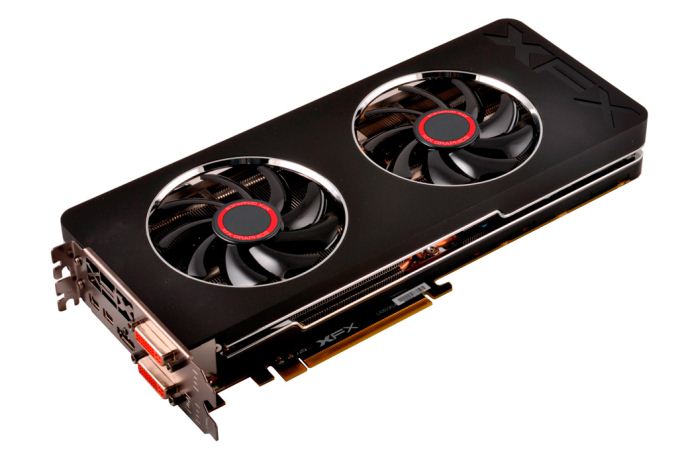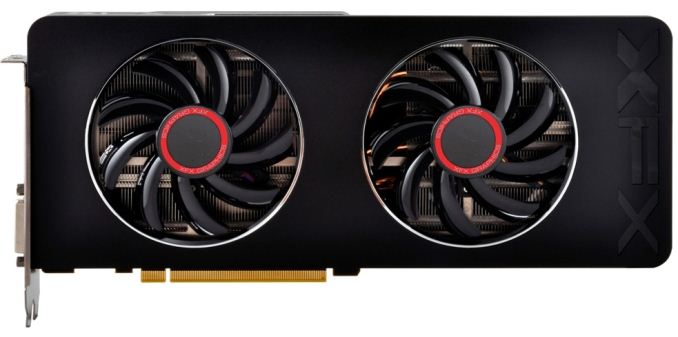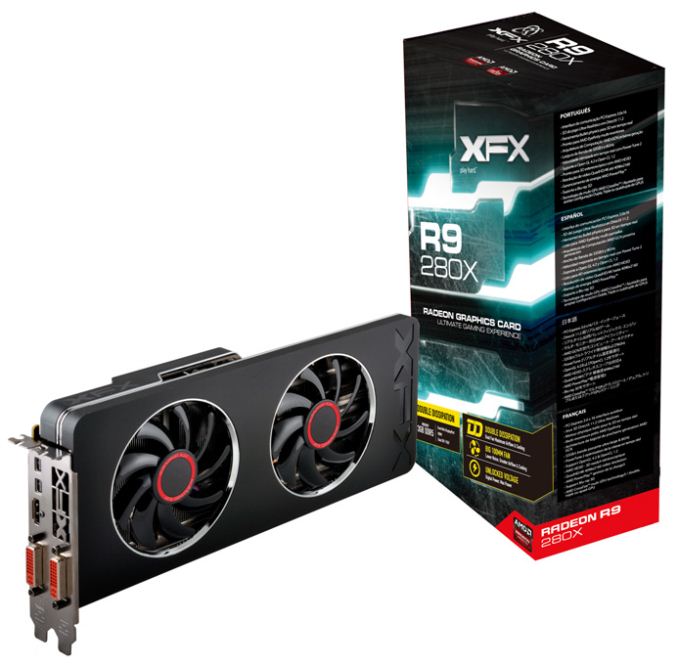The Radeon R9 280X Review: Feat. Asus & XFX - Meet The Radeon 200 Series
by Ryan Smith on October 8, 2013 12:01 AM ESTXFX Radeon R9 280X Double Dissipation
The first of our R9 280X cards is our reference-like sample, XFX’s Radeon R9 280X Double Dissipation. The R9 280X DD is XFX’s sole take on the 280X, utilizing a new and apparently significantly revised version of XFX’s Double Dissipation cooler, and paired with a 280X operating at the 280X’s reference clocks of 850MHz core, 1000MHz boost, and 6GHz RAM. Since there isn’t an overclock here, XFX will primarily be riding on their cooler, build quality, and other value add features.
Diving right into the design of the card, the R9 280X DD is a fairly traditional open air cooler design, as is common for cards in this power and price range. This basic design is very effective in moving large amounts of heat for relatively little noise, making the usual tradeoff of moving some of the cooling workload onto the system’s chassis (and its larger, slower fans) rather than doing the work entirely on its own.
In XFX’s case this is a new design, having forgone their older Double Dissipation design that we first saw on their 7970BEDD back in 2012. What’s changed? Without going into minute details, practically everything. At first glance you’re unlikely to even recognize this as an XFX card due to the fact that this is the first such product from XFX using this design, which aesthetically looks almost nothing like their old design.
First and foremost XFX has gone for the oversized cooler approach, something that’s become increasingly common as of late, equipping the card with one of the larger coolers we’ve ever seen. At 100mm in diameter the two fans on XFX’s design are among the biggest we’ve ever seen, pushing the card to just over 11.1 inches long while causing the heatsink and shroud to stand about 0.75” taller than the board itself.
Drilling down, XFX is using a two segment heatsink, the combined length of which runs the complete length of the card. Providing heat conduction between the GPU and the heatsink is a set of 6 copper heatpipes mounted into a copper base plate. 4 of these heatpipes run towords the rear of the card and the other 2 to the front, perpendicular to XFX’s vertical fin heatsink. Meanwhile cooling for the various discrete components on the board, including the memory, is provided by a separate cut-out baseplate that covers most of the card. There isn’t any kind of connection between the baseplate and the heatsink proper, so it’s the baseplate and any airflow over it that’s providing cooling for the MOSFETs it covers.
Moving on to XFX board, it looks like XFX isn’t doing anything particularly exotic here. XFX is using their standard Duratec high-end components, which includes using solid caps and chokes (typical for all cards in this power category) along with their IP-5X dust free fan. A quick component count has us counting 7 power phases, which would be the reference amount for a 280X, meaning we’re looking at 5 phases for the GPU, and another 2 phases for the memory and I/O.
Meanwhile for I/O XFX implements the common Radeon display I/O configuration of 2x DL-DVI, 1x HDMI, and 2x Mini DisplayPort 1.2. All the while external power delivery is provided by a set of 6pn + 8pin power connectors, as to be expected for a 250W card. With that in mind XFX’s design should have at least some overclocking headroom, but XFX doesn’t provide any overclocking software so you’ll need to stick with Catalyst Overdrive or 3rd party utilities such as MSI Afterburner.
Finally, as a Double Dissipation product the 280X DD is covered by XFX’s lifetime warranty policy, contingent on registering the card within 30 days of purchase. Interestingly XFX remains one of the few board partners that still offers any kind of lifetime warranty, making them fairly exceptional in that regard. As for pricing we’re listing the XFX card at $329 at the moment, though there is still some confusion over whether that’s the final price or not as our XFX rep seemed unsure of that. As is sometimes the case in this industry, we get the impression that they were waiting to see what other manufacturers were going to charge, in which case we suspect the actual launch price will be lower than that. We’ll update this article once we have final pricing information available.













151 Comments
View All Comments
HisDivineOrder - Wednesday, October 9, 2013 - link
Well, they did it for the Geforce 7xx series, so they probably had to do it for the new Radeons. That said, it's nice for users to see how little things changed. You know, for the people who didn't pay attention.I agree though it's kinda boring that we're gonna be stuck on the same Radeon series for another 6 months or year. At least nVidia seems vaguely on track with Maxwell, though unless something changes dramatically I think AMD is going to be putting 0 pressure on nVidia to release Maxwell.
Mantle could put pressure if they manage to get it into the gaming engines like they want. If so, they could force nVidia to 1) release their own API (and pay to be put in the same engines) or 2) put out better and better hardware to stay in the high level API with better performance.
Or they could do option 3) and do both.
IUU - Thursday, October 17, 2013 - link
"These aren't new cards. They are basically the same GPU's AMD has been shipping for almost 2 years now and it looks like they are going to try and pass them off again for another year. Why was this treated as some big new thing with a long article and a bunch of benchmarks? This whole thing could have been done in a little 2 paragraph news blurb."Of course they are not new cards. I feel your frustration, but why would they be new?
They render crysis at 43 frames per second at a freaking 2560x1440 resolution, not to mention battlefield and other games. There is simply " no need" for new hardware because there are not p new games to justify stronger hardware. A stagnation in gaming industry would more appropriately describe the situation.
Not that there is nothing to add to improve visual quality of the games, they just won't do anything about it, at keast for now.
jasonelmore - Tuesday, October 8, 2013 - link
disappointing to say the least. People were thinking this would perform at 780 levels are going to be dissapointed. i feel sorry for those that pre-ordered last week for $650+EzioAs - Tuesday, October 8, 2013 - link
This is the 280X not the 290X....jasonelmore - Tuesday, October 8, 2013 - link
ahh ok, i wouldnt have even bothered with this detailed of a review on rebadges with new firmware.EzioAs - Tuesday, October 8, 2013 - link
We don't need you to bother anything when you don't even read the title much less the review itself.RyuDeshi - Tuesday, October 8, 2013 - link
Well seeing as you didn't even bother reading the first page I can see that.It's still worth reviewing so that when people are trying to compare current GPUs, they have updated benchmarks with newer firmware to support those purchase decisions. This goes for both the AMD and Nvidia cards. The worst part about looking up old reviews of say the 7970 (which this is a rebadge of) is that most of them are with older firmware, and AMD had a pretty nice boost a few months after their release which this review more accurately reflects.
jasonelmore - Tuesday, October 8, 2013 - link
well i tried to edit my post literally 10 seconds after i posted but nope, looks like were still browsing 1999 websites that dont let you edit or delete your comments. anyways, yes i should have read the whole article to make any sort of comment at all. sorry.jasonelmore - Tuesday, October 8, 2013 - link
btw the 1st page wasnt up yet, only the charts were posted when i read. this is the problem with posting reviews before they are done, and stuff.Morawka - Tuesday, October 8, 2013 - link
yeah that was annoying